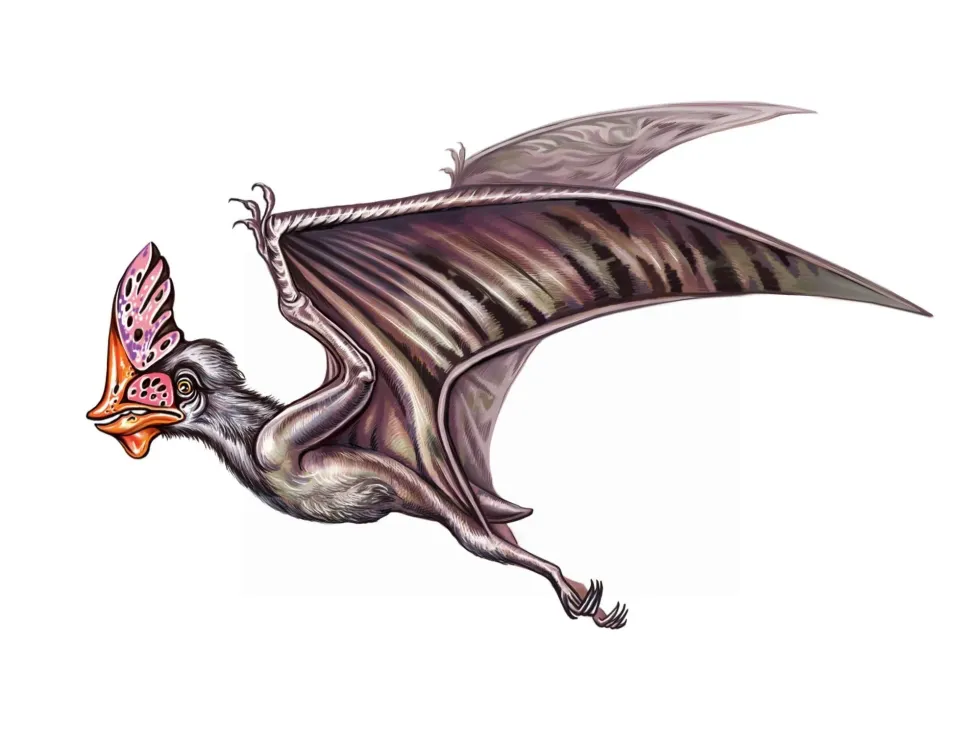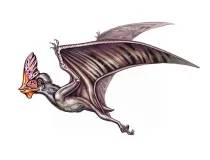Tapejara were known to have inhabited the range that included present-day Brazil, Hungary, Morocco, England, Spain, United States, and China as the fossil specimens were discovered in these places. The first and only valid type species of this genus is Tapejara wellnhoferi.
These pterosaurs lived in the Cretaceous period and the fossils dated to about 112 million years ago.
It was thought to be an arboreal creature and it is believed that it might have been lived in a ridge. It is also assumed that it might have reproduced in a similar way to other reptiles, that is, sexually, and either laid eggs or gave birth to live young.
Based on the discovered fossils, it has been recorded that Tapejara had bony crests that rose from the snout and some of them might have had larger crests to support the bony crest.
It had a large nasoantorbital fenestra and the front opening of the skull was half the length of the complete skull. The eye sockets were pear-shaped and small.
It also had curved claws because of which they were able to have a grip on surfaces and trees and it has been studied that this creature had a great vision.
The wings were known to protrude from near the belly and not the back. The wingspan is estimated to be around 55 in (140 cm), while some studies state that the wingspan is around 118-236 in (300-600 cm).
The diet was considered to be carnivorous and it is believed that it fed on the carrion of other animals, but for a long time, it had been speculated that this pterosaur might have been omnivore or frugivore.
Another two types that were first considered a part of this family include T. navigans and T. imperator but were later classified under new genera by two partners Unwill and Martin. The specific name of the type species was kept in honor of Peter Wellnhofer, a German paleontologist. This reptile appeared on the BBC 'Walking With Dinosaurs' in 1999.
It is quite fascinating to explore this creature and if you are interested, read about Peteinosaurus and Batrachognathus.
Tapejara Interesting Facts
Was the Tapejara a dinosaur?
No, the Tapejara was not a dinosaur, it was a pterosaur, a flying reptile.
How do you pronounce 'Tapejara'?
The pronunciation of this dinosaur is 'Taa-pe-ha-raa'.
What type of prehistoric flying bird was a Tapejara?
It was classified as a pterosaur, that is, a flying reptile.
In which geological period did the Tapejara live?
These pterosaurs are known to be from the Cretaceous period from around 112 million years ago.
When did the Tapejara become Extinct?
The time period of extinction of this Cretaceous species is unknown.
Where did a Tapejara live?
The fossils and specimens of this species were found in present-day Brazil, Hungary, Morocco, England, Spain, United States, and China.
What was a Tapejara's habitat?
Not a lot is known about the habitat of this pterosaur from the Early Cretaceous time range, but it is thought that it might have been an arboreal creature.
Who did a Tapejara live with?
Not much is known about this animal being solitary or living in groups.
How long did the Tapejara live?
The lifespan of the Tapejara is not known.
How did they reproduce?
Not much information is available about the reproduction of this animal, but it might have reproduced sexually like other reptiles. It is a possibility that it either used to lay eggs or gave birth to live young.
Tapejara Fun Facts
What did a Tapejara look like?

The Tapejara had a bony crest that aroused from the snout and was known to be formed from the bones of the premaxillary of the tip of the upper jaw. It has been recorded that some species had an even larger crest to support the bony crest.
This larger crest was made of fibrous and softer tissue that extended from the back of the skull behind the head. These crests were considered to be an interesting feature.
This genus is known to be characterized by the large nasoantorbital fenestra. The main opening in front of the skull is almost half the length of the entire skull.
The eye sockets were known to be pear-shaped and small.
The claws were curved and may have helped in perching on the trees and other surfaces. The dentary crest was known to be a more developed anteroposteriorly.
Studies and analyses of the brain of this pterosaur have stated that they had a great vision. The shoulder girdles of the Tapejara were likely to be unusually reduced and were slung low on the torso and this led to the wings protruding from near the belly than the back.
How many bones did a Tapejara have?
The exact number of bones that this flying reptile, from the Early Cretaceous period, had is not known.
How did they communicate?
Communication might have taken place through sounds, gestures, and postures.
How big was the Tapejara?
Tapejaras were around 9 in (23 cm) in length. It is considered to be a small to medium-sized pterosaur and the wingspan is estimated to be around 55 in (140 cm) which is medium to large.
How fast could a Tapejara move?
The moving speed of this animal is not known.
How much did a Tapejara weigh?
They weighed around 14.8 oz (420 g).
What were the male and female names of the species?
Males and females of this species do not have any sex-specific names.
What would you call a baby Tapejara?
Baby Tapejaras might have been referred to as young or juveniles.
What did they eat?
It is believed that this pterosaur might have fed on the carcasses of dead animals.
How aggressive were they?
Not much can be determined about the aggressiveness of this flying reptile as not much content is available about the behavior of this creature.
Did you know...
It is considered to be a genus of Brazilian pterosaurs and three Brazilian pterosaurs have been studied extensively through reconstruction including Tapejara.
Tapejara lived from the Cretaceous time period and the fossil was discovered by Peter Wellnhofer in the Santana Formation and it dates to around 112 million years ago.
Although these reptiles are not dinosaurs, they used to live in the same time range as dinosaurs, that is, they lived from 112-109 million years ago.
Other bigger types were later included as a part of Tapejara and those are Tapejara navigans and Tapejara imperator, but later analysis found out that the two types were quite different from the T. wellnhoferi and were not related, and thus, were placed into new genera.
History states that T. imperator was placed in its own genus named Tupandactylus and it was given by Alexander Kellner and Diogenes de Almeida Campos.
However, later, partners Unwill and Martin found that T. navigans and T. imperator were related and actually belonged to the same genus, and thus, were reclassified under another genus and were known as Ingridia navigans and I. imperator. This name was given in the honor of the late wife of Wellnhofer, Ingrid, as this species history states.
The first and only type species that is considered to be valid by the researchers is Tapejara wellnhoferi.
The specific name is kept in the honor of Peter Wellnhofer, a German paleontologist.
It is believed that the most primitive genera were known to have been discovered in China which indicated that this family had its origins in Asia.
Tapejara were considered to have more curved claws as compared to other azhdarchoid pterosaurs based on research references. The claws were most likely used to create a grip on trees and other surfaces.
According to the research, it has been stated that they were found in the fossil sites where other flying arboreal vertebrates were found, too, like the early birds.
It has been speculated for a long time that these creatures may have been frugivores or omnivores and this was speculated on the basis of their parrot-like beaks as stated by the species history.
Some members of the Tapejaridae family included macro predatory and raptorial types that were adapted to prey on large animals, too.
The research of comparisons between the scleral rings of modern reptiles and birds and Tapejara suggest that it might be cathemeral, that is, for short intervals in the day, it was active.
It is to note that the Tapejara dinosaur also features in the game Jurassic World.
A Tapejara is on display at the Museum of Ancient Life in Utah.
Why are they called Tapejara?
It is from a Tupi word, meaning the 'old being' but the reason for this name is unknown.
When did Tapejara go Extinct?
The exact time frame of the extinction of this pterosaur is not known.
Here at Kidadl, we have carefully created lots of interesting family-friendly prehistoric animal facts for everyone to discover! Learn more about some other creatures from our Sordes fun facts, or Darwinopterus facts for kids.
You can even occupy yourself at home by coloring in one of our free printable Tapejara coloring pages.
Second image by Kabacchi.










